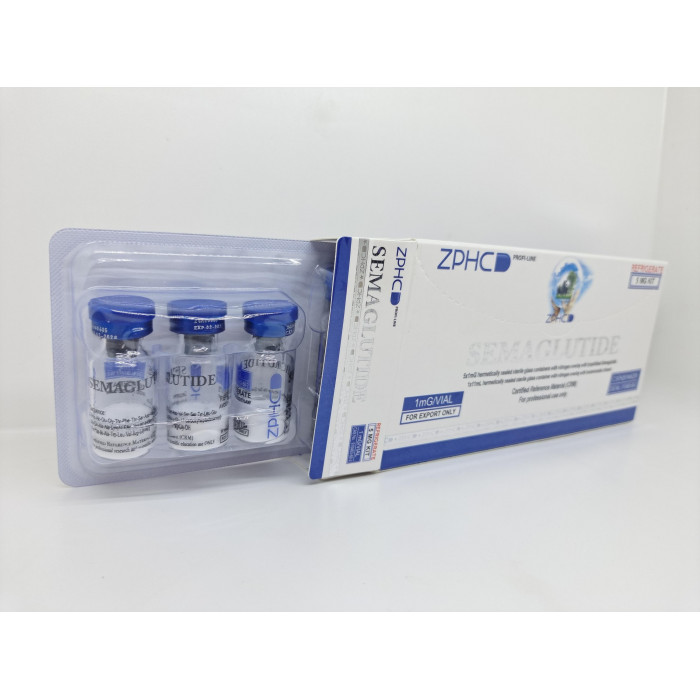Semaglutide 5mg ZPHC for sale
Semaglutide is derived from GLP-1 which is a peptide that has been observed to lower blood glucose level and increase the secretion of insulin. Some studies also demonstrated that Semaglutide could have positive effects on the function of heart, liver and lungs and could slow or halt the progression of Alzheimer’s. Thus, Semaglutide has the ability to reduce appetite by maintaining in the stomach for a long time and also reducing the movement of the intestines. Ramifications of Glucose Levels on Secretion of Insulin and Glucagon Can be Managed by Glucagon-Like Peptide-1 (GLP-1) Analogs. Buy Semaglutide 5mg online for your personal using you can without prescription in our web shop.
Survey of Semaglutide and GLP-1
GLP-1 is an abbreviation of glucagon-like peptide-1, a short peptide hormone consisting of only thirty to thirty-one amino acids. Its main physiological role is to reduce blood glucose concentrations by increasing the secretion of insulin. It also plays a role in protecting the insulin stores of beta cells, stimulating the transcription of insulin genes and is associated with neurotrophic functions in the brain and CNS. In the GI system, GLP-1 has been shown to reduce appetite through mechanisms of gastric emptying delay and slowing of intestinal contractions. In addition, experimental initiatives have revealed possible consequences of GLP-1 in the heart, fat, muscle, bone, liver, lung, kidney and other parts of the body too.
The principal area of research into GLP-1 has focused primarily on diabetes mellitus/treatment and prevention of obesity. Secondary research has concentrated on the cardiovascular effects of the peptide. More recent, and therefore more speculative, studies have looked at the ability of GLP-1 to prevent neurodegenerative diseases. This last area is the newest in the literature, but it is also a rapidly expanding area of GLP-1 research now that the peptide has been shown to slow or even halt the formation of amyloid-beta plaques associated with Alzheimer's disease.
Semaglutide Composition
Sequence: HXEGTFTSDVSSYLEGQAAK-OH.steric diacid-EFIAWLVRGRG
Molecular Formula: C187H291N45O59
Molecular Weight: 4113.64 g/mol
PubChem CID: 56843331
CAS Number: 910463-68-2
Synonyms: Semaglutide, Oxempic, Rybelsus, NN9535
Research involving Semaglutide and GLP-1
The Effect of GLP-1 as an Incretin Hormone
The last but not least effect of GLP-1, according to Dr Holst, is called the "incretin effect", a group of metabolic hormones released from the small intestine that lead to a decrease in blood glucose or sugar. GLP-1 has been demonstrated to be one of the two most effective hormones in increasing the incretin effect in rodents, the other being GIP. While GIP travels through the bloodstream at about 10 times the concentration of GLP-1, it has been found that GLP-1 is much more effective than GIP, especially when high blood glucose concentrations are present.
There is a specific GLP-1 receptor on the outside of pancreatic beta cells, and it can be seen that GLP-1 directly causes the release of insulin from the pancreas. In patients with type 2 diabetes, when taken with sulfonylurea drugs, GLP-1 stimulates insulin release to the extent that symptomatic hypoglycemia occurs in up to 40% of patients. Of course, increased insulin secretion is related to several nutritional effects, including an elevated rate of protein synthesis, a reduced rate of protein degradation, and a higher uptake of amino acids by skeletal muscle.
Protection of GLP-1 and Beta Cells
Animal studies have also shown that GLP-1 has the potential to promote pancreatic beta cell development, and new research suggests that GLP-1 can induce pancreatic ductal epithelial progenitor cells to develop into beta cells. Descriptive studies have also indicated that GLP-1 can prevent beta cell apoptosis. The combination of these effects shifts the net balance of beta cell proliferation and apoptosis in favour of proliferation, which is why the peptide could be used to treat diabetes and to protect the pancreas from injury that negatively affects beta cells.
One of the most convincing studies has proved that GLP-1 has a sceptical effect on beta-cell death with an increase in inflammatory cytokines. In fact, studies using genetic mouse models of type 1 diabetes have demonstrated that GLP-1 also has a direct effect in protecting pancreatic islet cells from destruction, which may have a potential role in preventing the development of type 1 diabetes.
Some Words about GLP-1 and Appetite
Research on mice shows that injecting GLP-1 and the GLP-1 receptor into the brains of mice significantly slows calorie intake and reduces obsession with food. Now, it seems that GLP-1 might somehow help to increase this feeling of satiety, or the ability to feel full, thus reducing hunger.
Clinical trials with the current controlled experiments in mice show that twice-daily doses of GLP-1 receptor agonists promote a steady, though constant, loss of body weight. In addition, there was a reduction in haemoglobin A1C, a measure of the severity of the disease and a benchmark of the glycaemic control achieved by treatment.
The Possible Cardiovascular Effects of GLP-1
GLP-1 receptors are expressed throughout the heart in humans and the receptor stimulates certain aspects of cardiac usefulness by increasing the general rate of rhythmic contractions and the amount of left ventricular end diastolic pressure. The latter may not appear to be much but raised LV end-diastolic pressure is a sign of LV hypertrophy, cardiomegaly, and terminal heart failure. More contemporary research data have pointed to the possibility that GLP-1 can help reduce the total extent of the damage in heart attack.
From the looks of it, the peptide increases the rate of uptake of glucose in cardiac muscles, thus assisting the ailing ischemic heart muscles to obtain necessary nutrients to continue with their function instead of being signalled to undergo cell death.
The enhanced rate of glucose picking up in these cells is well thought out as not insulin mediated. Intravenous administration of large doses of GLP-1 increases the LV performance and decreases SVR in the dog. The latter can assist in lowering blood pressure and relaxing the load on the heart also as a consequence. This, in turn, can minimise the degree of LV remodelling, the increase in arterial wall thickness, and the development of heart failure as a complication of high blood pressure.
Dr. Holst has established that when dosed following cardiac damage, “GLP-1 receptors have constantly raised the levels of myocardial performance not only in experimental animal models but also amongst the patients”.
About GLP-1 and the Brain
As a result, there is some evidence that GLP-1 can improve learning and act as a protective shield for neurons in neurodegenerative diseases such as Alzheimer's. In addition, a study has shown that GLP-1 has an effect on the ability of mice to learn and process memory, as well as reversing learning deficits in mouse models with specific gene deletions. When the GLP-1 receptor is overexpressed in certain regions of the rat brain, both learning and memory are improved compared to normal rats.
Further studies in mice have also shown that GLP-1 acts as a neuroprotective agent against excitotoxic neuronal damage; it even rescued all rat models of neurodegeneration from glutamate-induced apoptotic death. This peptide can even induce neurite regeneration in cultured cells. One can only imagine that further studies using GLP-1 will show the method to halt or even reverse some neurodegenerative diseases. In particular, GLP-1 and its receptor agonist, exendin-4, have already been reported to suppress amyloid-beta deposition in the brain and also beta-amyloid precursor protein in neurons in mouse models.
Amyloid-beta is the main protein in the plaques seen in Alzheimer's disease, which, although not known to cause the disease, are proportional to the severity of the disease. Whether or not stopping the build-up of amyloid beta can protect against the effects of Alzheimer's disease, this research is an indication of how researchers may try to interrupt the progression from mild cognitive impairment to Alzheimer's disease.
The minor side effects it causes are negligible to moderate, and it has high oral bioavailability in mice but excellent subcutaneous bioavailability. The dosage in mice per kg body weight is different from that in humans. Here at Peptide Sciences we present GLP-1 specifically for research purposes and not for use as a drug or in food products. Therefore, only a licensed researcher should purchase GLP-1.

No questions about this product, be the first and ask your question.









